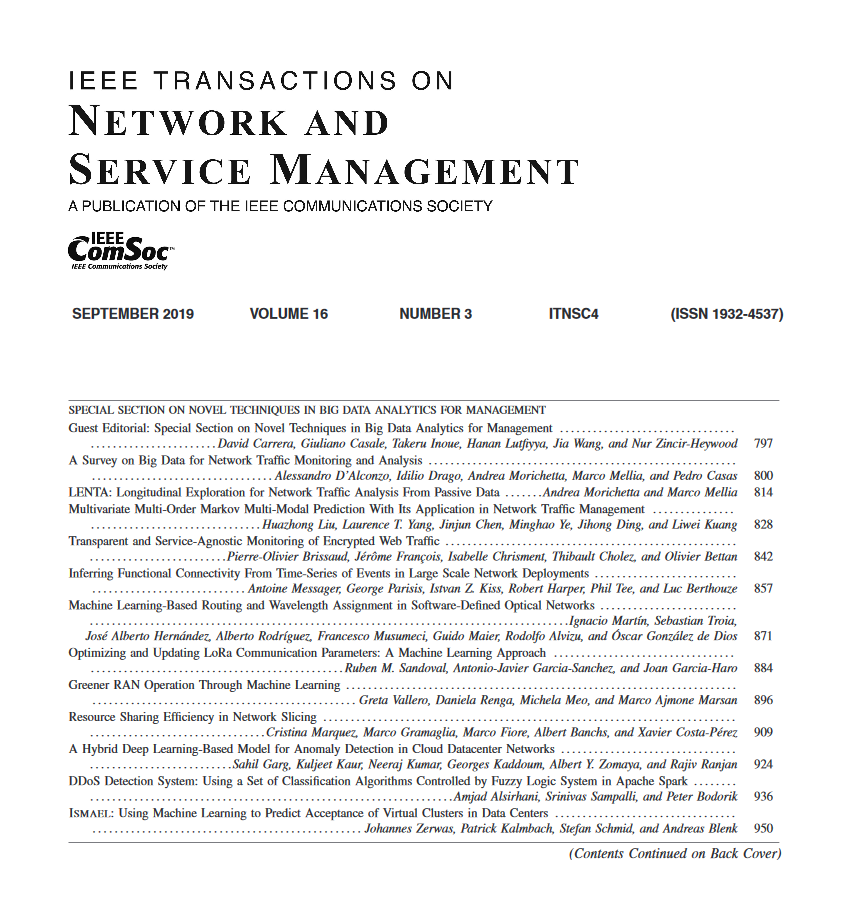数字孪生和 NOMA 辅助互联自主车载系统中具有流行意识的服务缓存和卸载
IF 4.7
2区 计算机科学
Q1 COMPUTER SCIENCE, INFORMATION SYSTEMS
IEEE Transactions on Network and Service Management
Pub Date : 2024-09-17
DOI:10.1109/TNSM.2024.3462481
引用次数: 0
摘要
5G/B5G通信的扩散导致数字孪生(DT)技术和连接的自动驾驶汽车系统(CAVS)之间的集成增加。复杂且资源密集型的车载应用对自动驾驶汽车的连接性和性能提出了重大挑战。为了提高网络连通性、优化频谱分配和缓解网络拥塞,采用了非正交多址(NOMA)技术。此外,通过在车辆网络边缘存储和卸载相关服务,采用了卸载和服务缓存。然而,由于车载边缘服务器的缓存存储有限,缓存流行和紧急服务以最小化延迟和能耗的决策变得具有挑战性。关于计算卸载和服务缓存的决策也是强耦合的。在这项工作中,研究了DT和noma辅助的CAVS (DTCAVS)中的流行感知服务缓存和卸载问题(PSCAOP)。pscop的数学构造和观察是np完全的。然后提出了一种量子启发粒子群优化算法(DTCAVS-QPSO),以最小化延迟和能量消耗。dtcav - qpso优先考虑流行的和紧急的服务缓存。对量子粒子(QP)进行编码,为pscop提供了一个全面的解决方案。使用一次性映射算法对qp进行解码。考虑时延、能耗和服务类型,建立了适应度函数。在多项式时间内观察到DTCAVS-QPSO的所有相位都是有界的。通过广泛的模拟和基于假设的统计分析,证明了所提出的DTCAVS-QPSO的意义。实验结果强调了DTCAVS-QPSO优于其他标准工作,表明平均延迟和能耗降低在6%到49%之间。本文章由计算机程序翻译,如有差异,请以英文原文为准。
Popularity-Conscious Service Caching and Offloading in Digital Twin and NOMA-Aided Connected Autonomous Vehicular Systems
The proliferation of 5G/B5G communication has led to increased integration between digital twin (DT) technology and connected autonomous vehicular systems (CAVS). The complex and resource-intensive vehicular applications pose significant connectivity and performance challenges for CAVS. To improve connectivity, optimize spectrum allocation, and mitigate network congestion, non-orthogonal multiple access (NOMA) is implemented. Furthermore, offloading and service caching are employed by storing and offloading relevant services at the edge of vehicular networks. However, due to the limited caching storage of vehicular edge servers, the decision to cache popular and emergent services to minimize delay and energy consumption becomes challenging. The decisions regarding computation offloading and service caching are also strongly coupled. In this work, a popularity-conscious service caching and offloading problem (PSCAOP) in a DT and NOMA-aided CAVS (DTCAVS) is studied. PSCAOP is mathematically constructed and observed to be NP-complete. Then a quantum-inspired particle swarm optimization (QPSO) algorithm is proposed for DTCAVS (DTCAVS-QPSO), aiming to minimize delay and energy consumption. DTCAVS-QPSO prioritizes the popular and emergent service caching. The quantum particle (QP) is encoded to provide a comprehensive solution to the PSCAOP. A one-time mapping algorithm is used to decode the QPs. The fitness function is formulated considering delay, energy consumption, and type of service. All the phases of DTCAVS-QPSO are observed to be bounded in polynomial time. The significance of the proposed DTCAVS-QPSO is demonstrated through extensive simulations and hypothesis-based statistical analysis. Experimental outcomes underscore the superiority of the DTCAVS-QPSO over other standard works, indicating an average delay and an energy consumption reduction between 6% and 49%.
求助全文
通过发布文献求助,成功后即可免费获取论文全文。
去求助
来源期刊

IEEE Transactions on Network and Service Management
Computer Science-Computer Networks and Communications
CiteScore
9.30
自引率
15.10%
发文量
325
期刊介绍:
IEEE Transactions on Network and Service Management will publish (online only) peerreviewed archival quality papers that advance the state-of-the-art and practical applications of network and service management. Theoretical research contributions (presenting new concepts and techniques) and applied contributions (reporting on experiences and experiments with actual systems) will be encouraged. These transactions will focus on the key technical issues related to: Management Models, Architectures and Frameworks; Service Provisioning, Reliability and Quality Assurance; Management Functions; Enabling Technologies; Information and Communication Models; Policies; Applications and Case Studies; Emerging Technologies and Standards.
 求助内容:
求助内容: 应助结果提醒方式:
应助结果提醒方式:


